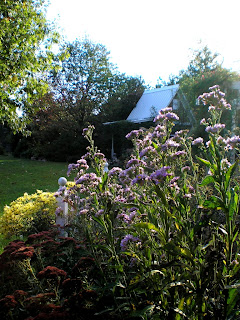 |
| Perennial chrysanthemums brighten any fall garden. |
Fall has so much to offer us...much cooler temperatures, endless foliage colors, and rain. Walking around my garden yesterday to take blog pictures took much longer than I thought it would, not because I could not find plants to photograph, but I just could not decide which plants photograph. (All the pictures in this blog were taken October 25, 2010.)
While most of my asters have finished blooming, Aster tataricus 'Jindai' is in full flower. This tall aster has a stiff, upright habit and blooms well past October. The 1" clusters of bright blue flowers with glowing yellow centers is a perfect partner for perennial chrysanthemums.
 |
| Itea 'Little Henry' |
 |
| Fothergillia |
 |
| Penny Mac and Sambucus Black Lace |
 |
| Moudry |
Late blooming anemones do not easily give up and continue to flower, as do some of the roses. Hyssops that were cut back late summer are still flowering. And while the blooms on butterfly bushes have slowed down quite a bit, they continue to push out some new blooms.
But the true stars of my late October gardens are
the peren- nial chrysan- themums And do they know how to ham it up! Sheffields demand attention of anyone who passes by. Shrugging off frost, these flowers will last well into November without blinking an eye. I would never garden without perennial chrysanthemums.
I hope my fall gardening series has encouraged you to discover the enjoyment of fall gardening.
While we often search for plants that offer beauty, sometimes all we have to do is to take time to see the beauty.
Two books I highly recommend for seasonal gardening:
Time-Tested Plants by Pamela J. Harper and
Continuous Bloom by Pam Duthie
Related blogs:
Colorful Fall Gardening, Part 1
Colorful Fall Gardening, Part 2
Colorful Fall Gardening, Part 3
Mums the Word












